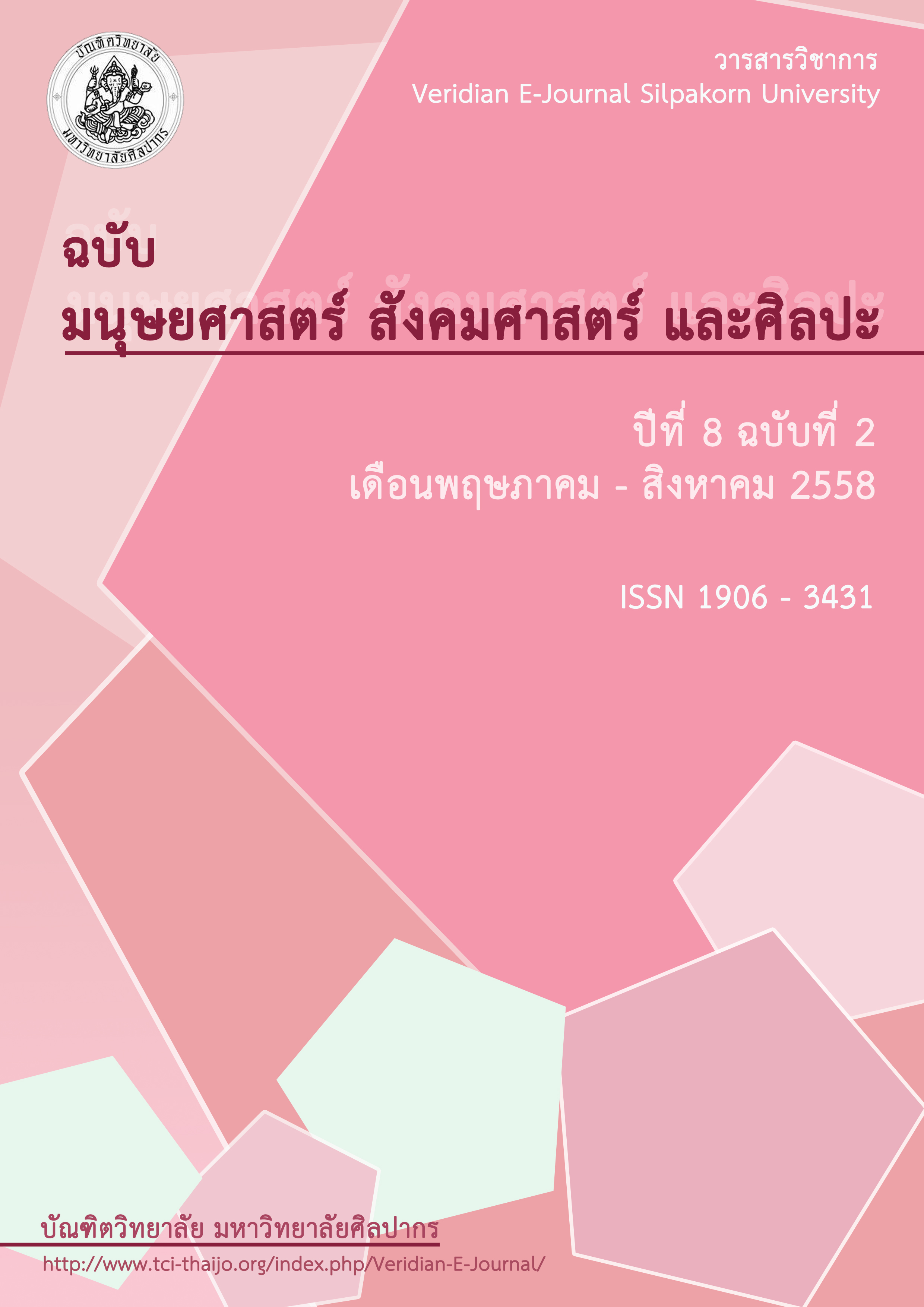การพัฒนารูปแบบการสอนวรรณคดีไทยโดยประยุกต์ใช้อริยสัจสี่เพื่อส่งเสริมความสามารถด้านการอ่านอย่างมีวิจารณญาณและการแก้ปัญหาเชิงสร้างสรรค์ของนักศึกษาระดับปริญญาบัณฑิต
Main Article Content
Abstract
บทคัดย่อ
การวิจัยครั้งนี้มีวัตถุประสงค์เพื่อพัฒนารูปแบบการสอนวรรณคดีไทยโดยประยุกต์ใช้อริยสัจสี่ เพื่อส่งเสริมความสามารถด้านการอ่านอย่างมีวิจารณญาณและการแก้ปัญหาเชิงสร้างสรรค์ของนักศึกษาระดับปริญญาบัณฑิต และเปรียบเทียบความสามารถด้านการอ่านอย่างมีวิจารณญาณและการแก้ปัญหาเชิงสร้างสรรค์ของนักศึกษาก่อนใช้ ขณะใช้และหลังใช้รูปแบบการสอน กลุ่มตัวอย่างคือนักศึกษาชั้นปีที่ 3 สาขาวิชาภาษาไทย คณะศึกษาศาสตร์ มหาวิทยาลัยศิลปากร จำนวน 28 คน เครื่องมือที่ใช้ ได้แก่ รูปแบบการสอนวรรณคดีไทย แผนการจัดการเรียนรู้ แบบวัดความสามารถด้านการอ่านอย่างมีวิจารณญาณ และแบบวัดความสามารถด้านการแก้ปัญหาเชิงสร้างสรรค์ วิเคราะห์ข้อมูลเชิงปริมาณโดยใช้ค่าเฉลี่ย ส่วนเบี่ยงเบนมาตรฐาน การทดสอบค่าที และวิเคราะห์ข้อมูลเชิงคุณภาพโดยการวิเคราะห์เนื้อหา ผลการวิจัยสรุปได้ดังนี้
รูปแบบการสอนวรรณคดีไทยโดยประยุกต์ใช้อริยสัจสี่เพื่อส่งเสริมความสามารถด้านการอ่านอย่างมีวิจารณญาณและการแก้ปัญหาเชิงสร้างสรรค์ของนักศึกษาระดับปริญญาบัณฑิต มี 4 องค์ประกอบ ได้แก่ หลักการ วัตถุประสงค์ กระบวนการเรียนการสอน และปัจจัยสนับสนุนการนำรูปแบบการสอนไปใช้ กระบวนการเรียนการสอนมี 7 ขั้นตอน ประกอบด้วย 1.เร้าความสนใจ 2.อ่านวรรณคดี 3.วิเคราะห์ความขัดแย้ง 4.วิเคราะห์สาเหตุ 5.ค้นหาวิธีแก้ไข 6.ผลของการแก้ปัญหา และ 7.สรุปและประเมินผล ผลการทดลองใช้รูปแบบการสอนทั้งกับกลุ่มตัวอย่างและการนำผลการศึกษาไปขยายผลพบว่า นักศึกษาทั้งกลุ่มทดลองและกลุ่มที่นำผลการศึกษาไปขยายผลต่างมีความสามารถด้านการอ่านอย่างมีวิจารณญาณและการแก้ปัญหาเชิงสร้างสรรค์สูงกว่าก่อนเรียนด้วยรูปแบบการสอนอย่างมีนัยสำคัญทางสถิติที่ .05 และระหว่างเรียนมีพัฒนาการสูงขึ้นอย่างต่อเนื่อง
Abstract
The purposes of research were to: develop an instructional model by applying the four noble truths and compare critical reading and creative problem solving abilities of students before, during and after being taught by the instructional model. . The samples of this research were 28 3rd year students majoring in Thai, the faculty of education at Silpakorn University. The research instruments employed in this research were an instructional model, lesson plans, critical reading abilities tests and creative problem solving abilities tests. The quantitative data were analyzed by mean (), standard deviation (S.D.), and t-test dependent. The qualitative data were analyzed by content analysis. The research results were as follows:
The instructional model by applying the Four Noble Truths to enhance critical reading and creative problem solving abilities of undergraduate students consisted of 4 components; principles, objectives, process and factors supporting learning. The learning process comprised 1) stimulating 2) reading literary work 3) analyzing conflict 4) analyzing cause of conflict 5) finding problem solutions 6) results of problem solutions, and 7) summarizing and evaluating.
The results of implementation with the sample and disseminating revealed that students critical reading and creative problem solving abilities were significantly higher than before being employed the instructional model at .05 level of statistical significance and increase continuously.

